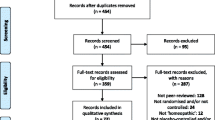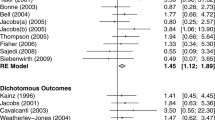Abstract
Context
Economic evaluations of commonly used complementary and alternative medicine (CAM) therapies such as homeopathy are needed to contribute to the evidence base on which policy makers, clinicians, health-care payers, as well as patients base their health-care decisions in an era of constrained resources.
Objectives
To review and assess existing economic evaluations of homeopathy.
Methods
Literature search was made to retrieve relevant publications using AMED, the Cochrane Library, CRD (DARE, NHS EED, HTA), EMBASE, MEDLINE, and the journal Homeopathy (former British Homoeopathic Journal). A hand search of relevant publications was carried out. Homeopathy researchers were contacted. Identified publications were independently assessed by two authors.
Results
Fifteen relevant articles reported on 14 economic evaluations of homeopathy. Thirteen studies reported numbers of patients: a total of 3,500 patients received homeopathic treatment (median 97, interquartile range 48–268), and 10 studies reported on control group participants (median 57, IQR 40–362). Eight out of 14 studies found improvements in patients’ health together with cost savings. Four studies found that improvements in homeopathy patients were at least as good as in control group patients, at comparable costs. Two studies found improvements similar to conventional treatment, but at higher costs. Studies were highly heterogeneous and had several methodological weaknesses.
Conclusions
Although the identified evidence of the costs and potential benefits of homeopathy seemed promising, studies were highly heterogeneous and had several methodological weaknesses. It is therefore not possible to draw firm conclusions based on existing economic evaluations of homeopathy. Recommendations for future research are presented.

Similar content being viewed by others
References
Frass, M., Strassl, R.P., Friehs, H., Müllner, M., Kundi, M., Kaye, A.D.: Use and acceptance of complementary and alternative medicine among the general population and medical personnel: a systematic review. Ochsner J 12(1), 45–56 (2012)
World Health Organization (WHO): WHO Traditional Medicine Strategy 2002–2005. Geneva: WHO/EDM/TRM 2002.1
Fisher, P.: What is homeopathy? An introduction. Front Biosci E4, 1669–1682 (2012)
Linde, K., Mondras, M., Vickers, A., ter Riet, G., Melchart, D.: Systematic reviews of complementary therapies: an annotated bibliography. Part 3: Homeopathy. BMC Complement Altern Med 1:4. http://www.biomedcentral.com/1472-6882/1/4 (2001). Accessed 18 April 2012
Ernst, E.: A systematic review of systematic reviews of homeopathy. Br J Clin Pharmacol 54, 577–582 (2002)
Bornhöft, G., Wolf, U., von Ammon, K., Righetti, M., Maxion-Bergemann, S., Baumgartner, S., Thurneysen, A., Matthiessen, P.F.: Effectiveness, safety and cost-effectiveness of homeopathy in general practice: summarized health technology assessment. Forsch Komplementärmed 13(suppl 2), 19–29 (2006)
Kelner, M.J., Boon, H., Wellman, B., Welsh, S.: Complementary and alternative groups contemplate the need for effectiveness, safety and cost-effectiveness research. Compl Ther Med 10, 235–239 (2002)
Smallwood, C.: The role of complementary and alternative medicine in the NHS. An investigation into the potential contribution of mainstream complementary therapies to healthcare in the UK. http://www.getwelluk.com/uploadedFiles/Publications/SmallwoodReport.pdf (2005). Accessed 7 April 2012
Drummond, M.F., Sculpher, M.J., Torrance, G.W., O’Brien, B.J., Stoddart, G.L.: Methods for the economic evaluation of health care programmes, 3rd edn. Oxford University Press, Oxford (2005)
Higgins, J. P. T., Altman, D. G., Sterne, J. A. C.: Chapter 8: Assessing risk of bias in included studies. In: Higgins, J. P. T., Green, S. (eds.) Cochrane Handbook for Systematic Reviews of Interventions, Version 5.1.0 [updated March 2011]. The Cochrane Collaboration, 2011. http://www.cochrane-handbook.org Accessed 18 April 2012
Cochrane Consumers and Communication Review Group (Cochrane CCRG). Data extraction template for Cochrane reviews. Version 1.5.0, updated 3 May 2001. http://www.latrobe.edu.au/chcp/cochrane/resources.html Accessed 18 April 2012
Bachinger, A., Rappenhöner, B., Rychlik, R.: Socioeconomic effectiveness of Zeel comp.-therapy compared to patients with hyaluronic acid in patients suffering from osteoarthritis of the knee. [Zur sozioökonomischen Effizienz einer Zeel comp.-Therapie im Vergleich zu Hylauronsäure bei Patienten mit Gonarthrose.] [German] Z Orthop 134(4) (1996)
Feldhaus, H.W.: Cost-effectiveness of homoeopathic treatment in a dental practice. Br Homeopath J 82, 22–28 (1993)
Frei, H., Thurneysen, A.: Homeopathy in acute otitis media in children: treatment effect or spontaneous resolution? Br Homeopath J 90, 180–182 (2001)
Kneis, K.C., Gandjour, A.: Economic evaluation of Sinfrontal in the treatment of acute maxillary sinusitis in adults. Appl Health Econ Health Policy 7(3), 181–191 (2009)
Kooreman, P., Baars, E.: Patients whose GP knows complementary medicine tend to have lower costs and live longer. Eur J Health Econ (2010). doi:10.1007/s10198-011-0330-2
Paterson, C., Ewings, P., Brazier, J.E., Britten, N.: Treating dyspepsia with acupuncture and homeopathy: reflections on a pilot study by researchers, practitioners and participants. Compl Ther Med 11, 78–84 (2003)
Pomposelli, R., Piasere, V., Andreoni, C., Costini, G., Tonini, E., Spalluzzi, A., Rossi, D., Quarenghi, C., Zanolin, M.E., Bellavite, P.: Observational study of homeopathic and conventional therapies in patients with diabetic polyneuropathy. Homeopathy 98, 17–25 (2009)
Sevar, R.: Audit of outcome in 455 consecutive patients treated with homeopathic medicines. Homeopathy 94, 215–221 (2005)
Slade, K., Chohanand, B.P.S., Barker, P.J.: Evaluation of a GP practice based homeopathy service. Homeopathy 93, 67–70 (2004)
Thompson, E.A., Shaw, A., Nichol, J., Hollinghurst, S., Henderson, A.J., Thompson, T., Sharp, D.: The feasibility of a pragmatic randomised controlled trial to compare usual care with usual care plus individualised homeopathy, in children requiring secondary care for asthma. Homeopathy 100(3), 122–130 (2011)
Trichard, M., Chaufferin, G., Dubreuil, C., Nicoloyannis, N., Duru, G.: Effectiveness, quality of life, and cost of caring for children in France with recurrent acute rhinopharyngitis managed by homeopathic or non-homeopathic general practitioners. Dis Manage Health Outcomes 12(6), 419–427 (2004)
Trichard, M., Chaufferin, G., Nicoloyannis, N.: Pharmacoeconomic comparison between homeopathic and antibiotic treatment strategies in recurrent acute rhinopharyngitis in children. Homeopathy 94, 3–9 (2005)
Van Wassenhoven, M., Ives, G.: An observational study of patients receiving homeopathic treatment. Homeopathy 93, 3–11 (2004)
Witt, C., Keil, T., Selim, D., Roll, S., Vance, W., Wegscheider, K., Willich, S.N.: Outcome and costs of homoeopathic and conventional treatment strategies: a comparative cohort study in patients with chronic disorders. Compl Ther Med 13, 79–86 (2005)
Witt, C.M., Brinkhaus, B., Pach, D., Reinhold, T., Wruck, K., Roll, S., Jäckel, T., Staab, D., Wegscheider, K., Willich, S.N.: Homoeopathic versus conventional therapy for atopic eczema in children: medical and economic results. Dermatology 291, 329–340 (2009)
Paterson, C., Britten, N.: In pursuit of patient-centred outcomes: a qualitative evaluation of MYMOP2, measure yourself medical outcome profile. J Health Serv Res Policy 5, 27–36 (2000)
Herman, P.M., MCraig, B., Caspi, O.: Is complementary and alternative medicine (CAM) cost-effective? A systematic review. BMC Complement Altern Med 5, 11 (2005). doi:10.1186/1472-6882-5-11
Hulme, C., Long, A.F.: Square pegs and round holes? A review of economic evaluation in complementary and alternative medicine. J Altern Complement Med 11(1), 179–188 (2005)
Robinson, N., Donaldson, J., Watt, H.: Auditing outcomes and costs of integrated complementary medicine provision. The importance of length of follow up. Compl Ther Clin Pract 12, 249–257 (2006)
Weatherley-Jones, E., Thompson, E.A., Thomas, K.J.: The placebo-controlled trial as a test of complementary and alternative medicine: observations from research experience of individualised homeopathic treatment. Homeopathy 92, 186–189 (2004)
Walach, H.: Entangled–and tied in knots! Practical consequences of an entanglement model for homeopathic research and practice. Homeopathy 94, 96–99 (2005)
Walach, H.: Generalized entanglement: a new theoretical model for understanding the effects of complementary and alternative medicine. J Altern Complement Med 11(3), 549–559 (2005)
Relton, C., Torgerson, D., O’Cathain, A., Nicholl, J.: Rethinking pragmatic randomised controlled trials: introducing the “cohort multiple randomised controlled trial” design. BMJ 340, c1066 (2010). doi:10.1136/bmj.c1066
Malekzadeh, R.: POLYIRAN in primary and secondary prevention of cardiovascular disease in middle-aged and elderly Iranians. ClinicalTrials.gov Identifier: NCT01271985. http://clinicaltrials.gov/ct2/show/study/NCT01271985 (2012) Accessed 4 May 2012
National Institute of Health Research Collaboration for Leadership in Applied Health Research and Care, South Yorkshire (NIHR CLAHRC SY).: Participants–Research projects. http://clahrc-sy.nihr.ac.uk/index.html (2012) Accessed 4 May 2012
Relton, C., Bissell, P., Smith, C., Blackburn, J., Cooper, C.L., Nicholl, J., Tod, A., Copeland, R., Loban, A., Chater, T., Thomas, K., Young, T., Weir, C., Harrison, G., Millbourn, A., Manners, R.: South Yorkshire Cohort: a ‘cohort trials facility’ study of health and weight: Protocol for the recruitment phase. BMC Public Health; 11:640. http://www.biomedcentral.com/1471-2458/11/640 (2011) Accessed 4 May 2012
Hollinghurst, S., Shaw, A., Thompson, E.A.: Capturing the value of complementary and alternative medicine: including patient preferences in economic evaluation. Complement Ther Med (2007). doi:10.1016/j.ctim.2007.10.001
Brooks, R.: EuroQol: the current state of play. Health Policy 37(1), 53–72 (1996)
EuroQol Group: EuroQol: a new facility for the measurement of health related quality of life. Health Policy 16, 199–208 (1990)
Brazier, J., Usherwood, T., Harper, R., Thomas, K.: Deriving a preference-based single index from the UK SF-36 Health Survey. J Clin Epidemiol 51, 115–128 (1998)
Bridges, J.F.P., Hauber, A.B., Marshall, D., Lloyd, A., Prosser, L.A., Regier, D.A., Johnson, F.R., Mauskopf, J.: Conjoint analysis applications in health—a checklist: a report of the ISPOR good research practices for conjoint analysis task force. Value Health 14, 403–413 (2011)
Buxton, M.: Assessing the cost-effectiveness of homeopathic medicines: are the problems different from other health technologies? Br Homeopath J 89(Suppl 1), 20–22 (2000)
Acknowledgments
Thanks to Riikka Sievänen and Clare Relton for their comments on early versions of the article and Stephen Gordon for proofreading.
Author information
Authors and Affiliations
Corresponding author
Rights and permissions
About this article
Cite this article
Viksveen, P., Dymitr, Z. & Simoens, S. Economic evaluations of homeopathy: a review. Eur J Health Econ 15, 157–174 (2014). https://doi.org/10.1007/s10198-013-0462-7
Received:
Accepted:
Published:
Issue Date:
DOI: https://doi.org/10.1007/s10198-013-0462-7




